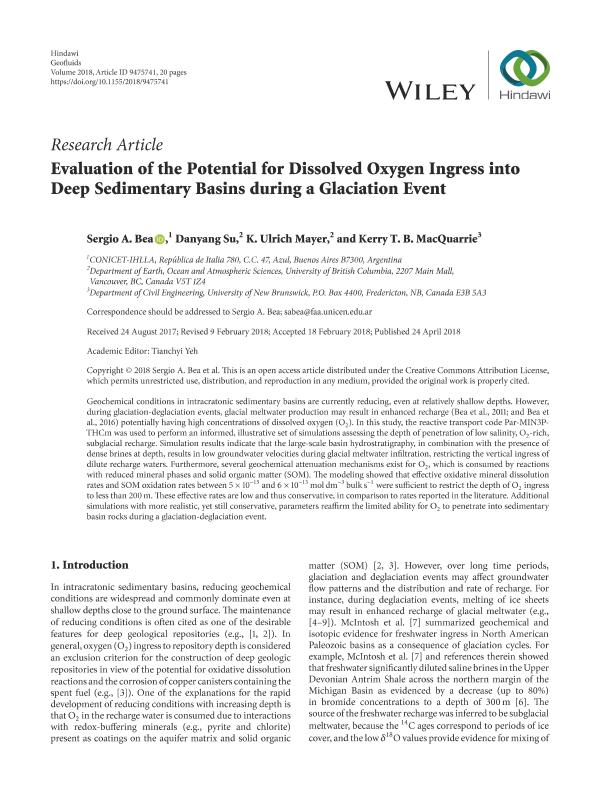Mostrar el registro sencillo del ítem
dc.contributor.author
Bea, Sergio Andrés

dc.contributor.author
Su, Danyang
dc.contributor.author
Mayer, Klaus Ulrich

dc.contributor.author
MacQuarrie, T. B.
dc.date.available
2020-01-30T19:23:10Z
dc.date.issued
2018-04
dc.identifier.citation
Bea, Sergio Andrés; Su, Danyang; Mayer, Klaus Ulrich; MacQuarrie, T. B.; Evaluation of the potential for dissolved oxygen ingress into deep sedimentary basins during a glaciation event; Wiley Blackwell Publishing, Inc; Geofluids; 2018; 4-2018; 1-20; 9475741
dc.identifier.issn
1468-8115
dc.identifier.uri
http://hdl.handle.net/11336/96258
dc.description.abstract
Geochemical conditions in intracratonic sedimentary basins are currently reducing, even at relatively shallow depths. However, during glaciation-deglaciation events, glacial meltwater production may result in enhanced recharge (Bea et al., 2011; and Bea et al., 2016) potentially having high concentrations of dissolved oxygen (O2). In this study, the reactive transport code Par-MIN3PTHCm was used to perform an informed, illustrative set of simulations assessing the depth of penetration of low salinity, O2-rich, subglacial recharge. Simulation results indicate that the large-scale basin hydrostratigraphy, in combination with the presence of dense brines at depth, results in low groundwater velocities during glacial meltwater infiltration, restricting the vertical ingress of dilute recharge waters. Furthermore, several geochemical attenuation mechanisms exist for O2, which is consumed by reactions with reduced mineral phases and solid organic matter (SOM). The modeling showed that effective oxidative mineral dissolution rates and SOMoxidation rates between 5 × 10-15 and 6 × 10-13 mol dm-3 bulk s-1 were sufficient to restrict the depth of O2 ingress to less than 200m.These effective rates are low and thus conservative, in comparison to rates reported in the literature. Additional simulations with more realistic, yet still conservative, parameters reaffirm the limited ability for O2 to penetrate into sedimentary basin rocks during a glaciation-deglaciation event.
dc.format
application/pdf
dc.language.iso
eng
dc.publisher
Wiley Blackwell Publishing, Inc

dc.rights
info:eu-repo/semantics/openAccess
dc.rights.uri
https://creativecommons.org/licenses/by-nc-sa/2.5/ar/
dc.subject
Reactive transport modeling
dc.subject
Thermal-Hydro-Chemical and Mechanical coupling
dc.subject
Sedimentary basins
dc.subject
Glaciation-deglaciation cycle
dc.subject
Oxygen ingress
dc.subject
Redox-buffering minerals
dc.subject
Solid organic matter
dc.subject.classification
Otras Ciencias de la Tierra y relacionadas con el Medio Ambiente

dc.subject.classification
Ciencias de la Tierra y relacionadas con el Medio Ambiente

dc.subject.classification
CIENCIAS NATURALES Y EXACTAS

dc.title
Evaluation of the potential for dissolved oxygen ingress into deep sedimentary basins during a glaciation event
dc.type
info:eu-repo/semantics/article
dc.type
info:ar-repo/semantics/artículo
dc.type
info:eu-repo/semantics/publishedVersion
dc.date.updated
2020-01-29T22:37:21Z
dc.identifier.eissn
1468-8123
dc.journal.volume
2018
dc.journal.pagination
1-20; 9475741
dc.journal.pais
Reino Unido

dc.journal.ciudad
Londres
dc.description.fil
Fil: Bea, Sergio Andrés. Universidad Nacional del Centro de la Provincia de Buenos Aires. Rectorado. Instituto de Hidrología de Llanuras - Sede Tandil. Provincia de Buenos Aires. Gobernación. Comisión de Investigaciones Científicas. Instituto de Hidrología de Llanuras - Sede Tandil; Argentina. Consejo Nacional de Investigaciones Científicas y Técnicas; Argentina
dc.description.fil
Fil: Su, Danyang. University of British Columbia; Canadá
dc.description.fil
Fil: Mayer, Klaus Ulrich. University of British Columbia; Canadá
dc.description.fil
Fil: MacQuarrie, T. B.. University of New Brunswick; Canadá
dc.journal.title
Geofluids

dc.relation.alternativeid
info:eu-repo/semantics/altIdentifier/url/https://www.hindawi.com/journals/geofluids/2018/9475741/
dc.relation.alternativeid
info:eu-repo/semantics/altIdentifier/doi/http://dx.doi.org/10.1155/2018/9475741
Archivos asociados
